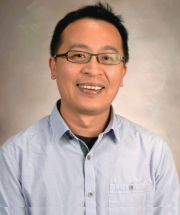
Kuang-Lei Tsai
Assistant Professor
The University of Texas Health Science Center at Houston
McGovern Medical School
Department of Biochemistry and Molecular Biology
Human diseases are often caused by abnormal gene expression, such as cancer. In human cells, gene expression is tightly regulated by many macromolecular complexes, such as coactivators, chromatin remodeling complexes, and long non-coding RNA molecules (lncRNAs). Studying their structures, dynamics, interactions, and molecular mechanisms is necessary for understanding how these complexes perform their cellular function. We combine the advanced cryo-electron microscopy (cryo-EM) techniques with various biochemical and biophysical approaches to explore the structures and functions of macromolecular assemblies that play important roles in gene regulation.
1. Structural and functional studies of the eukaryotic transcriptional Mediator complex and its interaction with the lncRNA.
The human 1.5 MDa transcriptional Mediator complex, consisting of 25 proteins and a dissociable CDK8 kinase module, plays an essential role in transcriptional regulation by conveying regulatory signals to the RNA Polymerase II transcription machinery. The dysfunction and dysregulation of the Mediator complex have been extensively linked to a variety of human diseases, including cancer. Our near-term goals are to 1) explore the molecular mechanism underlying Mediator regulation by lncRNA and 2) identify other new lncRNAs potentially linked to human diseases through interactions with the Mediator complex.
2. Macromolecular complexes involved in regulation of 3D genome architecture.
In cells, the structure of the 3D genome influences gene regulation, evolution, and cell fate decisions. How chromatin is organized within the nucleus and how genome architecture is regulated and maintained are important emerging biological questions. Numerous protein complexes that interact with nucleosome were identified to be possibly involved in the regulation of chromatin architecture. We use cryo-EM and molecular approaches to study the structure and molecular mechanism of important chromatin architectural proteins.
What students can learn from a tutorial in my laboratory:
Human cell culture, protein purification and characterization, operation of high-end electron microscopes, specimen preparation for cryo-EM, cryo-EM data collection and image processing, 3D mode building, and structural characterization.
McGovern Medical School Faculty
Education & Training
PhD, National Tsing Hua University, 2009







